#ua meta
Text
What is a smile to a war? : bnha 367
Have you ever wanted to die? Wish for the world to end? Have you ever lose yourself for a couple of minutes and felt like you wanted something really bad to happen to yourself or everybody else?
Has someone ever made you laugh in one of those cases— and just by that you realized how much you didn't want any of it to happen?
You were just upset.
Hold this concept in your mind, would you? Because the heart of the pro-hero thesis of bnha is that a hero not only saves your body or gets rid of the villains threatening you— they also save you from yourself sometimes, from the darkness within you; they prevent future tragedies with the force of their kindness.
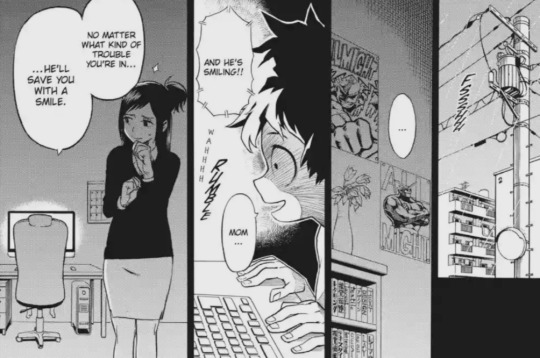
Kid Deku watching a video of All Might's debut:
And he's smiling!! Mom... no matter what kind of trouble you're in... he'll save you with a smile.
⠀When we were first introduced to Deku and his admiration for All Might, the one thing the story made emphasis on was All Might's smile. Why?
Because if you're afraid and you see the person rescuing you smile, you relax, it makes you feel better, it tones down your fear and anxiety.
It gives you hope.
I won't be able to put all the panels I wish I could show you to support this meta, so I'll rely on your good memory about the manga, okay?
⠀
During the Hero License arc, we learnt that being a hero is much more than just knowing how to fight. We already knew part of it from All Might's first session (take care of the situation with the minimum amount of damage to both the property and the people surrounding the fight).
We learnt that the way a hero saves a person matters. Their words, their attitude, how they carry themselves and how they approach the victims and situations, it all matters.
With Bakugou and Todoroki we learn that the job of a hero also implies daily services, like helping kids and guiding others, stuff Iida Tensei (former pro-hero Ingenium) used to do.
That's an idea that finds its development along many arcs, the maximum point being after the War arc, with Ochako's speech. When heroes were giving up, she reminded them it was not only about defeating the greater evil, but also about wanting to see everybody smile together again.
It is an echo of Nighteye lessons to Deku and Mirio, of course. An echo we see in bnha 367:
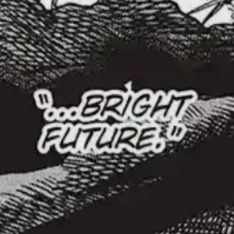
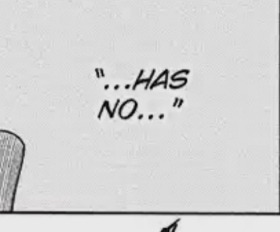

A world without smiles or honor... has no... bright future.
⠀As you know, my thesis is based on the idea that the major problem with the hero society was how they forgot what a real hero was, but not because everything was exclusively monetized (it was still part of the problem, I gotta admit). No, the major issue was exposed by Tomura Shigaraki in his first speech in front of the UA staff and students:
Violence became comfortable for the bnha world, mundane even, to the point heroes stop trying to find the root of the problems so they could treat it and the civilians stop trying to help because they thought it was the heroes jobs, not theirs. Serious issues were getting overlooked, the system was getting corrupted and the effort of the heroes was shallow, superficial, even if well-meant.

Tomura/Tenko in his thoughts:
Everyone just passed by, pretending not to see, thinking that some hero would save the day. Who decided to make the world this way?
AFO "rescuing" Tenko, kneeling down to hug him:
You'll be okay now... I am here.
⠀Let's take Nana Shimura as an example; she was a great hero, we all know, the one who trained Toshinori and taught him that the people who smiled when they were afraid were the strongest. However, she was not perfect and she shouldn't be regarded as such. She failed her son and her family, something Kotaro was right about.
Can a hero talk about justice if they sacrifice their families to save others? Why some lives matter more than others? Why are heroes allowed to decide who lives and who dies, instead of helping everyone they can equally in the measure of their context?

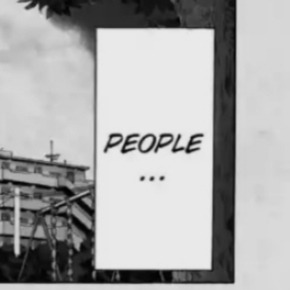
Bnha narration:
People... are not born equal.
What is a smile to a war?
You could ask what is the sacrifice of a kid for the safety of the world, right? A life for the safety of the entire planet?
For Endeavor, what were his children and his family for the glory of his name and the glory of the hero industry, for example?
What is Tomura to AFO? Toga to the media?
What is Deku —a quirkless kid— to an entire society of people with quirks and cool abilities?
⠀
We learned it through Kota in the Summer Camp arc and with Eri in the Overhaul arc. Both kids. One of them was a direct victim like Tomura of the hero society, the child of a broken family who had many reasons to hate what pro-heroes were; the other was a kid victim of the discrimination of quirks, a baby abandoned by her mother and used by criminal organizations for power and gain, just exactly what AFO did to Tenko/Tomura.
Deku could save Kota and Eri because he individually cared about them. No one told him there was a problem, he was actively looking. The same with Bakugo at the beginning, Deku didn't need a reason or a command, he didn't need the title or the suit, not even the quirk. He was doing the right thing.
Deku helped Kota because Kota was upset and he wanted to change that. He payed attention to Eri because she was crying. Same reason he found his way to help Bakugo, Todoroki and Iida.
What are they to Deku's journey of defeating AFO? Nothing. And everything.


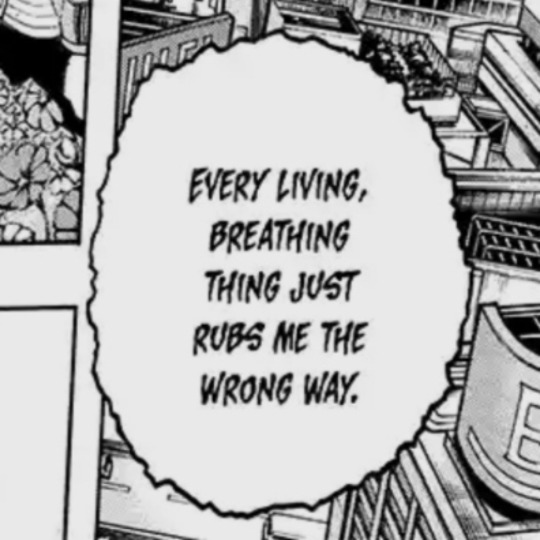
Tomura talking to Doc Garaki and the LOV:
Every living, breathing thing just rubs me the wrong way. That weight in my heart is never gonna go away. So why not destroy it all?
⠀During his fight with Endeavor, AFO asked Hawks what was evil, what could be categorized as "wrong", why everybody got so easily offended. Then revealed that his main motivation of being a villain was because he wanted to make everyone bitter, everyone, inspired on those comic books villains.
In a way, it means "I am bad, everybody's bad too"
On the other hand, Tomura's motivation to destroy it all comes for the trauma of not being rescued. Why? Didn't he deserve it? Why people wouldn't help him? Isn't it because he must play the part of a villain?
Tenko asked his mother why his father hated him. Tomara also asked the UA staff what was the difference between villains and heroes using violence, the same way Toga asked Uraraka why people wouldn't help or save them (the villains).
There is real inequality in bnha: you have people like Spinner, Shinso, Hawks, Toga, Deku, Aoyama, Dabi, Tomura, Shouto, Hatsume, Aizawa... The list keeps on growing.
There are differences. Preferences even.
If you're a pretty metahuman to be used by the hero commission or a filthy "mutant" with a weak quirk, if you have a spooky quirk or a "villain" quirk, if you're quirkless or your quirk is not flashy enough or powerful enough, if you look creepy or are not "hero material", if you are hero material even if you don't want to be one...
Inequality. Discrimination. Society prescriptions.
AFO almost won, he almost made everyone mad and bitter, including Deku in bnha 367.
⠀
Go read what Nighteye told Mirio again.
The fight against AFO (and what he represents) isn't a fight of just weapons. It was a fight with the hero society itself.
Their indifference, their apathy, their prejudices...
A smile matters in a war because why the fuck would you fight for if the only thing your gonna leave behind is a bunch of broken people who wish they were dead.
Why would you rescue Eri if you're not going to fight everyday with her trauma so that she can be happy? Why would you leave Kota to live in pain and anger without his parents when you can make his life full of light again?
What about the Cultural Festival arc?
Or rescuing Deku from his suicidal mission?
Going for Bakugo and Iida and fighting for Shouto to melt his heart??? Shouto going for Dabi???
This is why what Hawks did to Twice was wrong, because he forgot the principle of a hero:
Every lives matter.
Every smile matters.
The reason Tomura doesn't see a future is 'cause no one has ever showed him otherwise. No one saved him back then and no one has saved him (yet) in 20 years. No one told him he deserved to live and be happy, no one ever stopped and tried to make him smile or laugh or ask him if he had friends or if he liked dogs.
AFO killed Tenko the day he put those hands on him and has been dragging his body around in a parade— and even when Tomura was screaming about pain and injustice and screaming about the problem of the hero society, no one listened to him, no one tried ro reach him.
Dead.
Except Deku sees him.
⠀
Every moment of the manga, every mission and arc, every panel and interaction, it has brought us here: to Deku asking AFO if Tenko/Tomura is still in there.
What is Tenko's smile to the bnha war?
Maybe the end of it. Maybe the defeat of AFO. You have a wounded animal that will try to attack you because it's in pain. Here are your options: you can kill every wounded animal you encounter or you can go search for the cause of their pain and treat it, so the next generations won't arrive at your door full of desperation and rage.
Everyone can be a hero, because everyone can do the right thing, everyone can make others smile, everyone can save someone one day just by telling a joke or being gentle.
⠀
A smile can prevent a war.
Which is more powerful than any weapon which could stop at war.
In summary, bnha is about a society ruled by violence and miscommunication learning that if they don't reach for each other, if they don't try to understand, if their only solution is to erase what make them uncomfortable... they're doomed to dissappear.
#bnha#mha#my hero academia#boku no hero academia#Bnha meta#Mha meta#Bnha spoilers#Mha spoilers#Mha 367#Bnha 367#Shan's mha meta#Shan's bnha meta#Shigaraki Tomura#Deku#Midoriya Izuku#Afo#All for one#All Might#Toshinori yagi#Bnha manga spoilers#Deku meta#Midoriya Izuku meta#Shigaraki Tomura meta#Bakugou katsuki#Todoroki Shouto#Iida tenya#league of villains#lov#Ua students#Long post
630 notes
·
View notes
Text


It refers back to the scene where Shouto doesn’t actually join his friends, but rather waits for Endeavor and tells him (again) that they’ll face Touya together.


Which tracks with his whole battle. Shouto is separated from the rest of the class for now. And until Endeavor faces Touya, I think Shouto won’t be able to join them. Which is implied in Endeavor’s vision:

Which still makes me think that in the end Endeavor will choose to stay behind with Touya (maybe holding the line somewhere, or maybe simply staying with him if he’s injured) and will let Shouto to join his class for the end.
#aaaaaaw look at his face!!!#todoroki shouto#bnha volume 36#bnha volume 36 extras#bnha 325#bnha meta#Dabi#Endeavor#hawks#it's that moment Shouto runs inside UA#i'm glad we got this sketch of it#it ties also with Endeavor's thoughts on Shouto's path to join his classmates#why do endhawks look like proud parents????#mha spoilers#bnha spoilers#bnha volume 36 spoilers
325 notes
·
View notes
Note
You mentioned in this post that you think there's a central UA Artificial Intelligence, do you have any more headcanons about them?
We see some of them talking in the Sports Festival
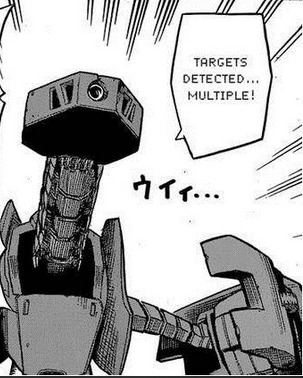


Notably the camera bots are cheering on the combat robots. I had forgotten about the medic bots, honestly, but they also speak.
Actually, looking closer, those medic bots are very similar to that One-Pointer model--perhaps the same designer?
The camera bots are also the ones who spot Midoriya and Bakugou during the Ground Beta confrontation and alert Aizawa. Interestingly, the robot calls Eraserhead, and responds to him. So that implies that each of the robots actually does have their own AI. Though again, that raises some ethical questions about the Entrance Exam.
Therefore, my conclusion is that the Camera and Medic bots have some form of human-level or near-human AI individual to each robot, while the combat models are directed by an 'overseer' AI which takes in the information gathered by the individual units to make large-scale tactical decisions. Almost like a Real Time Strategy game.
This 'Overseer' AI would also likely be in charge of UA's security. We know that UA uses sensors to detect people who should not be there--it's the reason Shigaraki had to decay the gate, and Thirteen mentions there are more at the USJ, so we can infer they're present across campus--the camera bots detect truant students. Since the camera-bot can call Aizawa, it can presumably also call Nedzu or the 'Overseer' as well if needed.
This 'Overseer' is also what monitors the UA Shelters/moving plates system to avoid Shigaraki's decay.
And until proven otherwise I will assume the 'Overseer' was made by Nedzu and Power Loader.
36 notes
·
View notes
Text
How the Quirk Singularity is like ChatGPT (or the AI of your choice)
I had this comment from @mhasuperfansblog a while ago, and I realized it’s worthwhile to talk about what “singularity” means, because yes, it IS a quirk controlling a user.
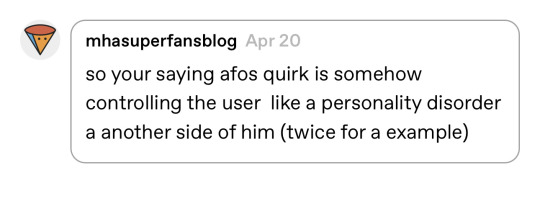
The literal meaning of “singularity” is “the state, fact, quality, or condition of being singular/unique/distinctive.” The word does NOT mean “many things converging into one.” Instead, a singularity marks a unique and rare point after which things are never the same and are wildly unpredictable. The old models must be thrown out and a new reality acknowledged. For example:
The Big Bang is theorized to be a singularity that created a universe — and space itself— from nothing
The infinitely dense and unstable material at the center of a black hole, which IMO is best explained via the movie Interstellar
The moment a butterfly flaps its wings to irreversibly change the weather on the other side of the world
What does this have to do with AI?
For many years, people with big brains have been predicting that the exponential growth of technology will inevitably come to a point when artificial intelligence surpasses the total of all human intelligence. We’ll reach a tech singularity point of no return, after which humans can’t reliably predict or control what happens. Once machines outsmart humans and replace all human jobs and human skills, humanity will become unnecessary; maybe even extinct. [Insert Terminator joke here about Skynet becoming self-aware.]
While the details are up for debate, the “tech singularity doomsday theory” has been around for a while and it isn’t exactly fringe. For example, Time Magazine published this article in 2014, tracing the theory back to a 1993 essay (which itself cites research papers from the 1950s-60s).
The graphic below is from 2005-07 and has been republished in various forms all over the internet. (I’m not going to debate accuracy, as the theory is the point.)

Which brings us back to MHA
When Horikoshi talks about quirk power growing exponentially with each generation, and quirks no longer being controllable by an individual, he’s not JUST talking about characters like Eri who have potentially destructive quirks. He’s talking about characters whose quirks take over them. Consume them.
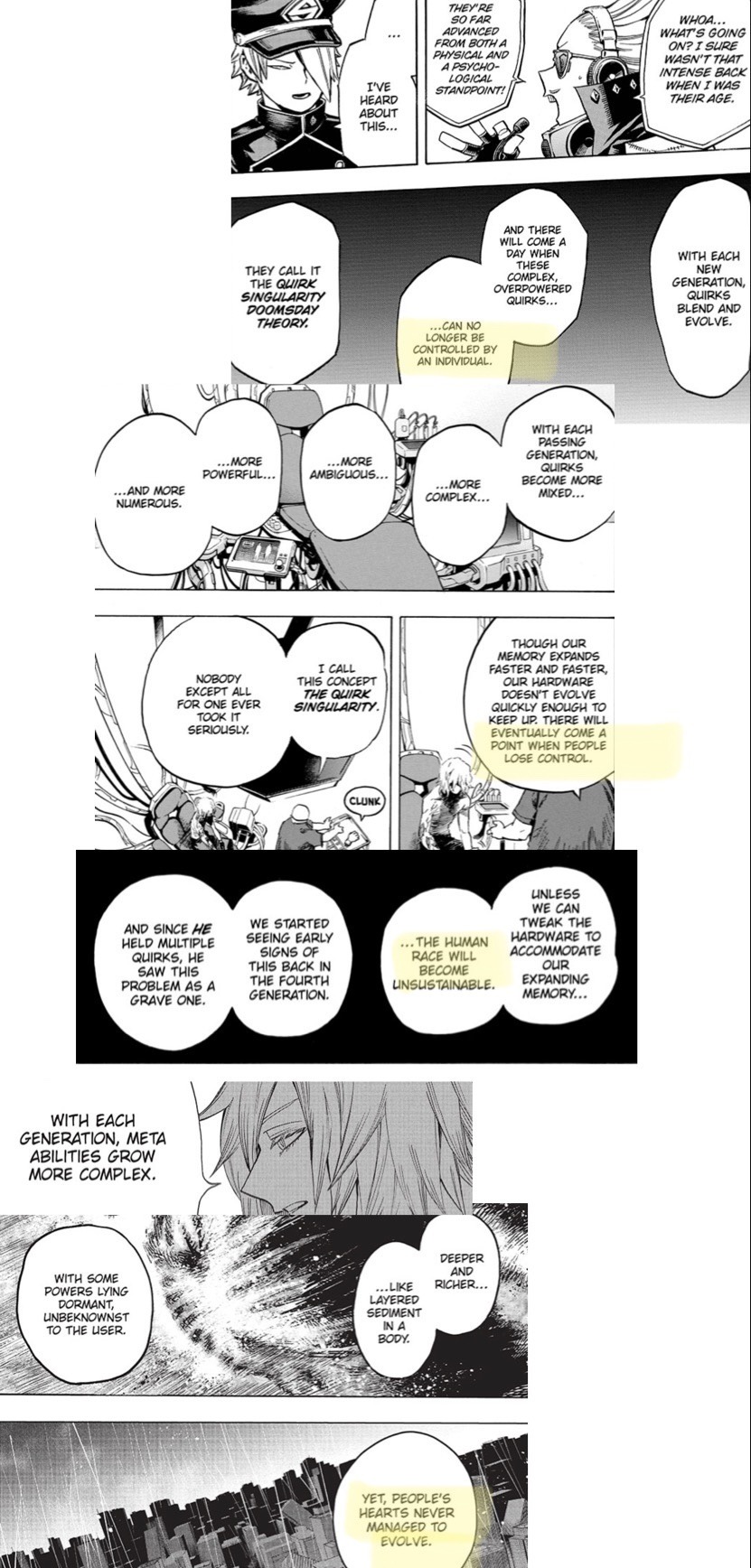
The Quirk Singularity Doomsday Theory is the point at which QUIRKS take over and drive human actions rather than the heart and soul that typically mark “humanity;” after this point people’s actions become unstable, irrational, and unpredictable. When quirks take over a body, the heart and soul slide towards extinction UNLESS people’s hearts evolve so their psychological makeup and emotional strength can rival —and control — their quirk power.
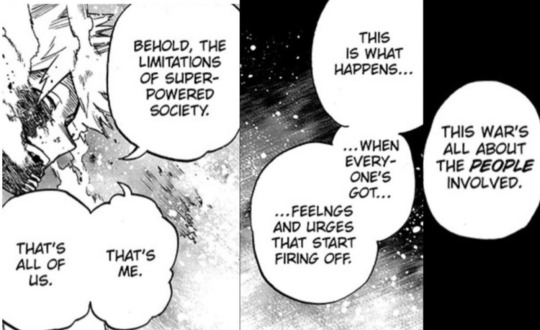
AFO became a demon lord by taking and giving quirks, eventually making his quirk into his name and personality. Naturally, he has an interest in controlling the singularity in some fashion. I’m not sure yet if he’s trying to stop the singularity to preserve his power over the world, or if he gave Tomura a singularity-proof body in order to survive and continue trading post-singularity quirks, but either way AFO is only looking at how quirks and physical bodies can control the problems presented by the singularity. Focusing only on the “hardware” is his limitation. Because heart is power and a threat to his eternal rule, he’s never “evolved his heart.” AFO is as hollow as he’s always been. Therefore, as his original body rewinds but his massive stolen quirk stockpile remains, AFO is becoming unstable. He doesn’t have sufficient heart, and is losing the physical body, to stop his quirk from taking over.
But how can the heroes win?
In the end, I suspect Horikoshi is going to give us a solution similar to those suggested by the tech singularity theorists and sci fi writers: We need to do more collectively, as a global society, to invest in the success of the next (human) generation, with an emphasis on cooperation, ethics & norms, increased communication, and carefully avoiding both the baggage of the past and the re-creation of the past’s elite class.
Of COURSE Horikoshi has given us a winking gag reference to both the Terminator and Asimov’s Three Laws of Robotics along the way just to make his point of view crystal clear, and that’s why I ADORE his combination of artistic talent and science/tech nerdery.
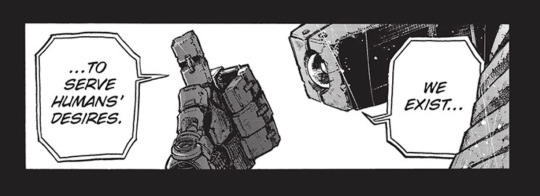
#bnha spoilers#mha spoilers#bnha 388#mha 388#bnha#mha#my hero academia#boku no hero academia#quirk singularity doomsday theory#quirk singularity#afo#all for one#bnha meta#mha meta#UA robots#terminator#three laws of robotics#isaac asimov
50 notes
·
View notes
Text
Hello, ladies and gentlemen. Yes, it is I, everyone's favourite favourite part-Irish, part-English, part-Welsh twat with yet more demented rambles to indulge in. I wish to talk about a problem I have felt with Boku No Hero for quite some time, one that I feel above all else has tarnished the series in regards to its quality of writing. So, here I am, jotting down my thoughts lest my head combust with it all. I shall try my hardest to keep the vociferous language to a minimum, if not outright eliminated, for I don't have much interest in hyperbole tonight. A basic little rundown of what I think may well have been the nails in BNHA's sacred palms.
Spoilers below the cut. But I'm sure you knew that already.
I would argue that this particular issue has been present in the manga persistently since Bakugo's non-sacrifice in Jaku. However, it only became truly evident to me in Chapter 295. The return of Mirio Togata. And hence, I introduce the problem.
Horikoshi has taken to writing scenes based on their emotional appeal- or 'cool factor'- first, and logic second. Yes, BNHA is a superhero shonen set in a far-future Japan, but that does not excuse it from following its own logical consistency. Every fictional world has its own logic, and that can be as different from ours as it could desire, but it must stick to that logic. In BNHA's case, Quirks have had relatively little impact on society as a whole aside from the obvious, it's still very much a world that can be compared to our own twenty-first century experience. This is all to say that yes, prioritising grandiose set pieces over common sense is not something that can be hand waved away, as this is not a series such as JoJo's Bizarre Adventure, which is built on an inherent silliness.
To better explain my point, I want to take a look at a few scenes that in particular highlight my frustrations. First of all, Togata's return. It's cool, he's kicking ass and taking names (not that poor Sako has any ass to kick at that point), and it's a huge moment for fans of his character. However, upon relatively brief inspection, it falls apart. Togata recovers his Quirk by having Eri rewind his body, a rather ethically questionable act that can further the already-established questions into the morality of UA and the Japanese government that this arc did serve to push. However, the act itself is never shown, nor are any potential consequences. Eri, a girl who is far too traumatised to use her Quirk, is never shown actually overcoming that fear. Neither character seems to struggle in any way with what happened. Furthermore, Togata just appears on the battlefield from nowhere, conveniently at the best possible time. What compelled UA to make such a choice? It's implied that Aizawa is now her legal guardian and with him on the front lines, who gave consent for Eri to undergo this process, in spite of the dangers to both herself and Togata? All of this to send one extra soldier into the war, a soldier who, for all his flash, only served to arrest a man who most likely would have died had he not been captured and hospitalised. Mirio Togata looks cool, his Quirk is cool and seeing him in action again is no doubt intoxicating for his fans; But the simple fact of the matter is that the terms of his return make absolutely zero sense. This is also without mentioning the fact that him reattaining his Quirk spits in the face of BNHA's main themes of taking life's harshness and making the most out of a bad situation, even when you've lost everything. Togata faced a tangible loss in the Hassaikai Arc, a loss that could have haunted him for the rest of his life. But he was content, and he refused to indulge in self-pity. He made the most out of his bad situation. Now, none of that matters anymore. And he hasn't even done anything of any relevance since then.
Exhibit B, Kaina Tsutsumi's death. I am aware that she technically is not dead (somehow; Clearly Horikoshi never realised that giving everybody absurd plot armour doesn't do anything to reduce the distraction of the protagonist's), but let's face it, she won't be returning again, so she may as well be. Tsutsumi is a character I rather enjoyed while she was around. A former government agent, the same breed as Hawks, who realised the depraved depths of her indoctrination and fought back against the system, only to be tossed into Tartarus for it. It's a fascinating idea, one that capitalises upon my love for gritty, grounded government conspiracy plotlines. What becomes of it, then? Well, Tsutsumi is blown up by All for One for disobeying his orders. How does she disobey them? After making clear her distaste for the blind optimism in the hero system displayed by indoctrinated youth, she is swayed to the side of 'righteousness' by Midoirya's blind optimism in the hero system. It is well established that Midoriya is the exact kind of person Tsutsumi despises, with his blind faith in what has been preached to him as justice and his somewhat self-absorbed hero complex, so for him to convince her, a hardened nihilist who had spent the last decade in one of the worst prisons in the country, of the light in the world by demonstrating exactly that is… Well, there are words to describe it that I'm not willing to say right now, so let's just settle on frustrating, shall we? A falling, burning Tsutsumi, caught by Hawks, the shot of her rain-swept face smiling warmly as her head blows apart is a catching visual, and that visual is what the whole scene is built on, once again sacrificing any actual internal or external logic, as well as what has been established for the characters involved.
For the final example, I want to illuminate the events of Chapter 377, the most recent to be leaked. I shan't be sharing any direct spoilers for this chapter here, but I wish to bring it in, for it perfectly embodies my point. A certain character reappears, a character with a relatively loyal fanbase, who has not appeared in many years. This character's return is no doubt cause for jubilation for some, but once again, the shock and awe of a beloved character coming back to the story is a mask for the lack of underlying logic for their return. This character's return was not in any way foreshadowed before the final few pages of the chapter. Considering that they are seen next to Tsukauchi, one would think that he would have bothered to at least hint at this at some point in the setup for the current war (even just a vague line like "We've got a few bargaining chips we can use, some strings to pull…" would be preferable to nothing). The fact of the matter is that their return has one purpose; The story's writing explicitly failed in that it made Skeptic too powerful of a threat. He is far away from any of the battlefields, has complete control over UA's systems and is clearly insane enough to kill everyone inside if given the chance. This is not something the story can allow, so it pulls out this character to correct how Horikoshi wrote himself into a corner. Of course, one should also note that, while they were shown to be fairly tech literate, to suggest that they are on par with Skeptic is utterly absurd. Once again, the wow factor is given more care than the quality of writing and internal consistency.
There are many more examples I could call upon. Bakugo's death and subsequent revival, the explosion of the Creature Rejection Clan mansion, anything involving All for One lately, the Stars And Stripes fight, I could go on. It's sloppy and it's lazy and it's killing the series that once stood at the top of the world. BNHA, like so many other shonen manga, is going out with a depressing whimper. It's almost as bad as Beastars. I said it. While it was never a perfect series, it did once have strong writing and consistency and that is why I still cherish a lot of the manga prior to the Jaku/Gunga Raid Arc.
For that reason, I wish to give an example of how in the past, Horikoshi avoided these pitfalls. The My Villain Academia Arc is heralded by many as the peak of the manga, and I am inclined to agree. Although not perfect, it has the strongest characterisation, world building and emotional draw of the series. So, I would like to take a moment to discuss how it ends. A powerful image. The great Re-Destro, always well-dressed, always immaculate, reduced to a naked, exhausted old man, bowing down to an angel of death, Tomura Shigaraki, the being he towered over mere minutes prior. It's a powerful image, one of my favourites in the series. In spite of that, Horikoshi does not use this image as a substitute for substance. Everything behind it is logical. It is well established that Yotsubashi's two key loves are for his ideology and human life, so in ceding control to Shigaraki, he is, in his mind, preventing further deaths and handing his future to who he sees as a fully liberated individual. As we soon see, this was a fatal mistake, for Shigaraki used the MLA as another tool in his path and ultimately discarded them once he was done, but it is clear to see why Yotsubashi saw it as the best option. The internal logic is consistent and sound. It's an example, one that wow factor does not have to be a substitute for satisfying storytelling, and that Horikoshi is far better than his recent output suggests. The man is ill, he's exhausted and he no doubt wants this Godforsaken series to end so that he can start writing something that he has passion for once again. I cannot blame him one bit. The reason I have written this is not to point and laugh at Horikoshi's failings; It is put into writing the heights that BNHA as a manga has fallen from, to its current point of mediocrity. No matter what, it will always be a series with moments that I shall hold dear. It was once something special, under that façade of bland shonen garbage and as much as that façade becomes the true face in the current state of the manga, I shall never forget how much it has helped me in the past.
Thank you very much for reading and I wish you a pleasant day. If you disagree, please don't hesitate to share why; Healthy discussion on opposing viewpoints is how media thrives.
#bnha critical#my hero academia#boku no hero spoilers#boku no hero academia#league of villains#Meta Liberation Army#UA#mha#my hero acedamia
20 notes
·
View notes
Text
Okay, you know what? I’m throwing down the gauntlet and am stating that All Might is one of the BEST teachers at U.A. Why? Because while he’s inexperienced and makes mistakes--a lot of mistakes-- he tries to do better and take action. Everyone else doesn’t.
After Bakagou was kidnapped, Nezu acknowledges WHY Bakagou was taken; his crazed, violent image made VILLAINS relate to him and turned the public against him.

ref: ch 83_pg6
Like it or not, Bakagou’s tantrum not only put a black mark on the school, but also placed Bakagou in danger (and the other students, but let’s not split hairs).
They acknowledge a problem, and what did they do about it? NOTHING. They did nothing! They admitted that there was an issue, spelled up why it was an issue, and did nothing to correct it!
Say what you will about All Might, but he’s a new teacher. One who doesn’t have a lot of social interaction because he had to keep his secret, so All Might doesn't have the skills to notice certain things. All Might is treading new territory. Of course, he’s making mistakes! But he’s actually learning and trying to do better. All the other U.A. teachers—like Aizawa and Nezu—have been teaching for at least a couple of years now. They should know better. (Especially Nezu who’s supposed to be a genius.) You can make the argument that Aizawa, due to being emotionally attached to Bakagou, is blind to his flaws, but Nezu shouldn’t. He should have sat Aizawa down and told him that he needed to correct Bakagou’s behavior for his own good. (To be fair, Bakagou did get a LITTLE better after his kidnapping, but my point stands.)
Sorry, I was working on a Mic post, and I came across the panel above, and it annoyed me.
#not to mention All Might's the only teacher we see ACTUALLY TEACHING#minus Mic that is#wow only the blonds are actually doing their jobs#go figure#yagi toshinori#Toshinori Yagi#All Might defense#UA critical#Bakagou critical#not really but just in case#bnha#mha#bnha meta#rant#mine#bakugou critical
58 notes
·
View notes
Text
“horikoshi, can we have koku and aino?”
“we have koku and aino at home!”
koku and aino at home:
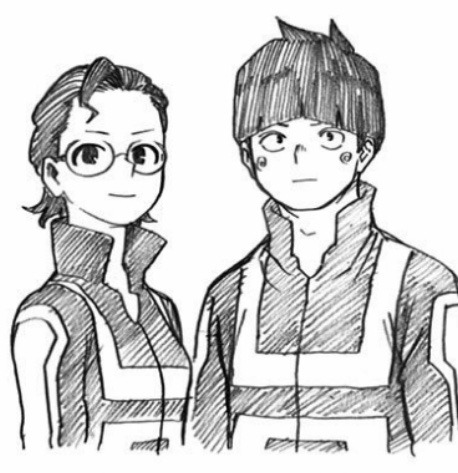
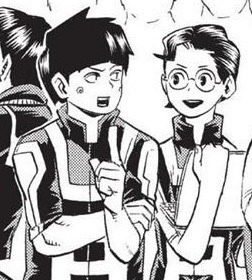
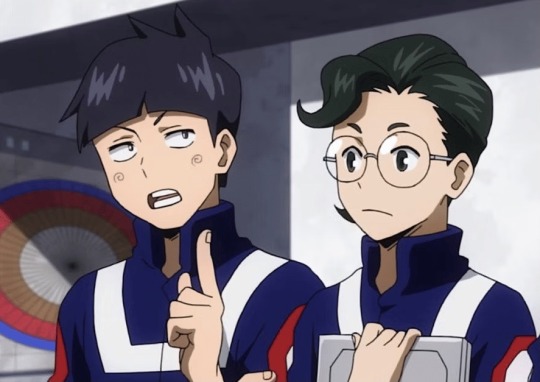
#hi im losing my mind over this#that glasses kid and trumpet didn’t even look that much alike at first#BUT THAT FIRST SKETCH LOOKS SO SIMILAR FOR SOME REASON???#aino mamoru#koku hanabata#trumpet bnha#aino bnha#ua high#meta liberation army#bnha#boku no hero academia#pretty sure the anime also slimmed aino kid down#which#BOOOOOOOOO
9 notes
·
View notes
Note
these sudden dozi questions got me nostalgic so i went back to re-read the older asks and at some point you seemed to have a lot you wanted to say about the lack of common sense in ua's teaching methods and i was wondering if you eventually posted your thoughts on that bc i would love to read all about them
There's tons of my thoughts in the #ua is a hell school tag but no I don't think I ever made a formal write up of all of them
#too many thoughts to just make a straight meta of it#possibly also the salt tag#ah remember the days when i got mountains of salt in my inbox...i was so young then#anon#pocket talks to people#ua is a hell school#adjacent
6 notes
·
View notes
Text
UA-META в Україні
UA-META український інформаційний ресурс
Website: https://ua-meta.com
1 note
·
View note
Text
What is an antagonist in My Hero Academia?
Okay, I saw stirrings of this topic rumbling about, and I just have to jump in this time. Please note that I am doing so gleefully and excitedly. This is meant to be fun.
With recent advents in the MHA story, apparently there are some who now want to call Tomura Shigaraki a deuteragonist, or even THE deuteragonist. I see why they're saying this. I think the urge lies in the potential that Shigaraki could turn on AFO and become a hero in some sense. He could join forces with Izuku Midoriya! I am here to argue that Shigaraki is absolutely not a deuteragonist, and I mean this as a good thing.
Tomura Shigaraki is an antagonist. He is the ULTIMATE antagonist. What is happening with him in the current story does not contradict that idea but enforces it.
An antagonist is a character acting in opposition to the protagonist. Right away you may say "Then if Shigaraki stops opposing Izuku Midoriya the protagonist, that would make him not an antagonist by definition!" Hold your horses, friends. I maintain that Shigaraki is an antagonist still. An antagonist is not someone who by definition must be destroyed by the protagonist just to be considered an antagonist in the first place.
Horikoshi has already set the terms for what constitutes antagonism in My Hero Academia. Antagonists are not antagonists because they fight against Izuku Midoriya; they are antagonists because they represent a large obstacle preventing Izuku Midoriya from saving someone.

Izuku Midoriya is a protagonist who exemplifies the desire to save people. His terms for victory are defined by saving people. It is this ideal that acts as the cornerstone for the story and inspires other characters to admire and follow in Izuku's footsteps.


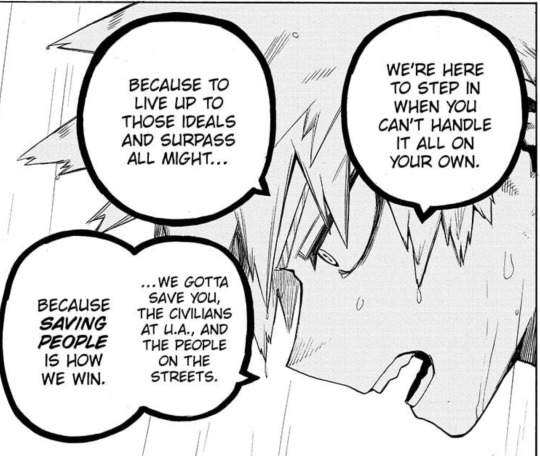
This is why Izuku is a radical, perspective-challenging character. He is not a bland protagonist in a generic shounen manga. MHA is in many ways a meta commentary on the genre and on storytelling itself. Izuku consistently demonstrates that, in a world of comic book superheroes, defeating an enemy in a fight holds little value for him. Everything is about rescue.
To demonstrate, I shall now show you some of Izuku's other antagonists.




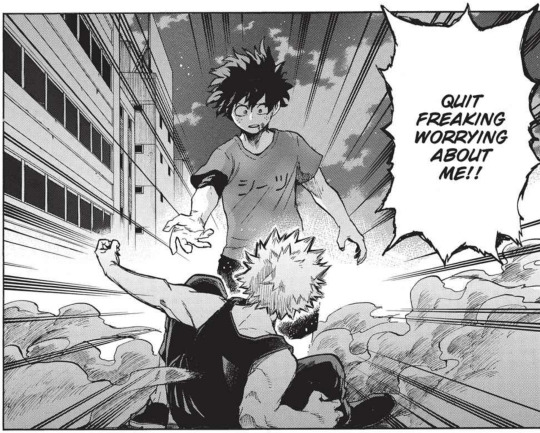

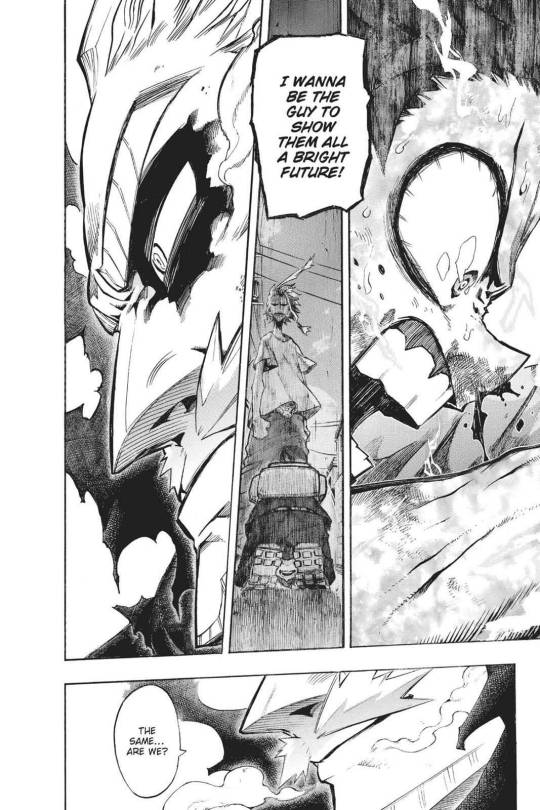
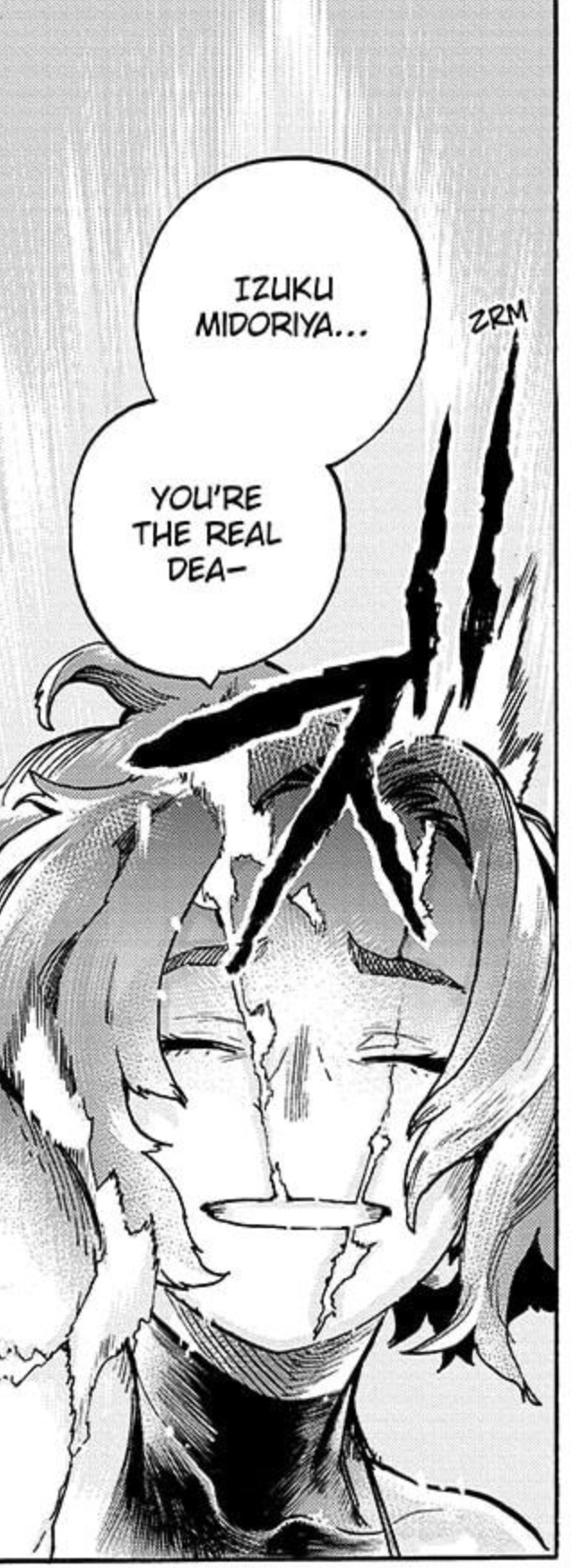
Now don't get me wrong. Izuku has other antagonists too, like Stain and Endeavor and Dabi and Overhaul and AFO--but those antagonists still are such in the sense that they are hurdles to Izuku saving someone.
Many of the above pictured characters are antagonists who even fight Izuku, and yet their battles culminate in Izuku saving them (or else partially saving and then punting the complete rescue to some other moment down the line if they're a recurring antagonist). The point is, they didn't cease to become antagonists the moment Izuku saved them either. Even in those moments when we see the results of their rescues, such as Shouto visiting his mother in the hospital and Inko allowing Izuku to return to UA and Katsuki rekindling his friendship with Izuku and Eri smiling for the first time in ages and Gentle joining the side of the heroes and Nagant turning her back on AFO, those moments were not the characters changing from antagonist to protagonist. They were the moments showcasing Izuku's victory and the arc's conclusion. Each of these characters serves as an antagonist for a particular story arc. So long as we're still within the same self-contained story arc, that character is still technically an antagonist even after Izuku has won. Their functional statuses as characters in a story only change when the story moves onto the next arc.
This means Shouto is an antagonist through the moment he visits his mother in the hospital for the first time because the scene serves to show us how Izuku has saved him. But then Shouto functionally changes so that he is no longer an antagonist in the next story arc. In the Stain arc, Shouto serves as a protagonist or co-protagonist or deuteragonist or tritagonist depending on how you wanna define those terms. Just because his role changes doesn't mean he isn't still an antagonist during the sports festival. He is! That change is the whole point!
So to bring this back to the ending, Shigaraki himself is an antagonist--and not just any antagonist. He is the overarching antagonist of the entirety of MHA! Because he, not AFO, represents the greatest threat to the protagonist Izuku Midoriya's ideals.

For every second Tomura Shigaraki rejects Izuku's helping hand, he threatens Izuku's worldview not just that all people have equal hearts in equal need of saving but that Izuku himself is equal to all others. This is the driving existential force that keeps Izuku doing what he does. To Izuku Midoriya, everyone is included in the whole. Everyone. Izuku included. Tomura included.
So now that Tomura may turn on AFO and may change his mindset, we don't have Shigaraki ceasing to be an antagonist. We have Izuku conquering his antagonist, that being Tomura's rejection of salvation. Tomura is becoming a person who can accept help, and that's precisely what has to happen to all of MHA's antagonists in their individual story arcs. These are the terms for the protagonist's victory. Tomura would not be undergoing this change if he wasn't an antagonist. To be an antagonist in MHA is a very important, fundamental role. We're just now seeing the resolution to Izuku's and Tomura's (or Tenko's, if you will) ultimate clash as protagonist and antagonist.
A deuteragonist has a very different role in MHA and that's a whole other post lol
#my hero academia manga spoilers#final arc spoilers#tomura shigaraki#tenko shimura#izuku midoriya#meta
125 notes
·
View notes
Text
Tomura's Kill count in Canon
I'm done with people calling Tomura a "sadistic genocidal mass murder who killed millions" BECAUSE HE ISN'T.
So, i finally decided to prove it my self.
So today I'll be listing EVERY person Tomura killed! With his reasons too.
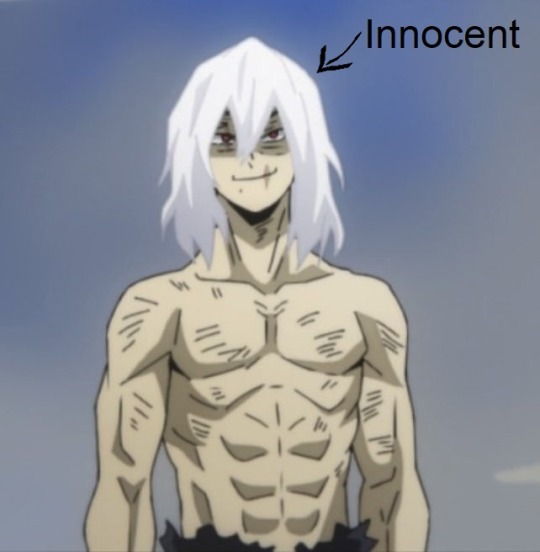
1- His father, his first intentional kill and one of the few he felt a thrill or pleasure, justified since he abused him.
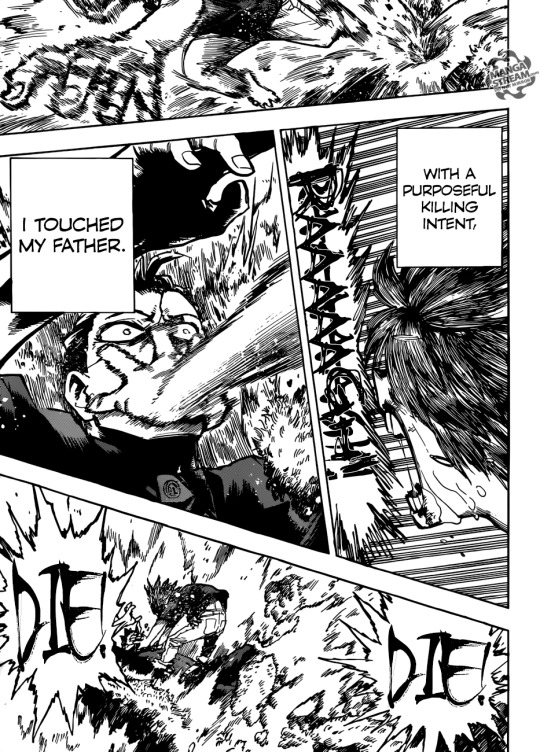
3- The two thugs, he killed them under AFO's pressure, and if you pay attention, he was wheezing during it the same way he did during his panic attacks.

Time skip to the present:
USJ had no kills (despite his attempts), Stain's arc had no kills either (except some papers and a binocular, RIP). No kills even during Kamino, as he seemed to not even want to kill Bakugou.
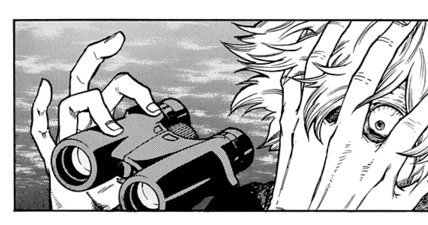
Tomura's first kill, chronologically, in the entire series, is ironically, only on the 4th season, and 11th story arc (Shie Hassaikai Arc)
4 kills so far, one of Overhaul's man, this kill was literally self defense (and revenge)

5- The cop driving the police car, guarding the ambulance Ovehaul was in (we don't know if he died or just lost his hand though, it might not have even been intentional considering he aimed to the steering wheel)
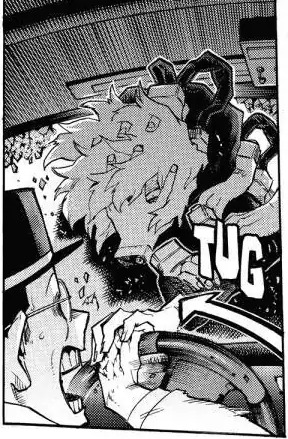
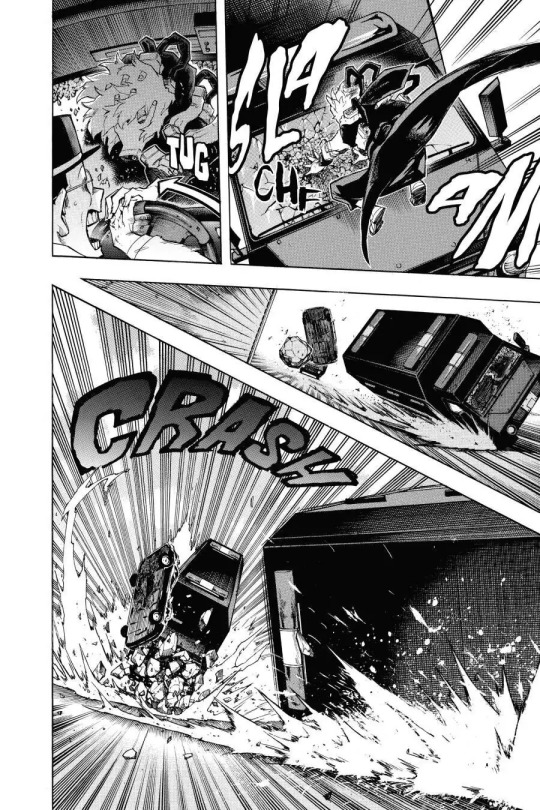
Then we have the Overhaul arm snatching scene, the only moment Tomura is shown as actually sadistic so far.
Totally owned though, Overhaul shouldn't have threatened him, killed and injured his friends
Then, we move to the MVA arc, where the real kill count starts
First, we have a unknown number of kills, when the league visits Creature Rejection Clan, there was around 20 visible members, assuming the kills where shared equally though the League, we can say Tomura killed around 5 or 6 of these guys.


Which he did with no Sadistic glee, actually, so far, he either kills with no emotions, or seems bothered by it (Also, racists, so owned 💅)
Anyways, around 10 kills by now.
2 kills, then i could count 32 people, so 44 kills.

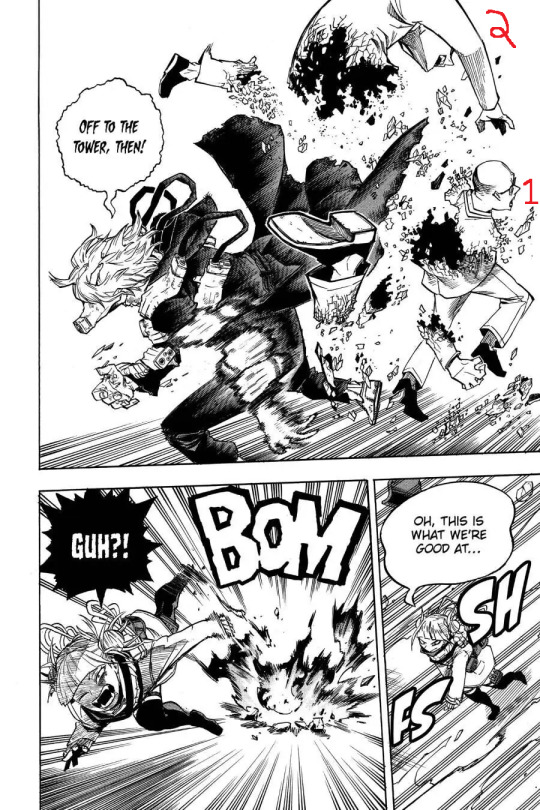
Considering Deika had 110,000 Meta Liberation members, and that good part of these people had died by GigantoMachia, Twice, Dabi and others.
We don't know though, how many where killed by Tomura's decay wave.
In the end Hawks had reported around 9,946 MLA members dead

I don't know if the kill wave should be counted though- since they weren't direct intentional kills
So by far Tomura has killed around 7,000 people, but none of them where innocent people (except that cop rip)
People left alive:
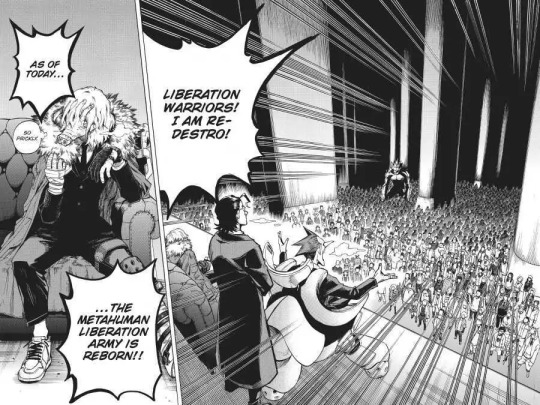
Now we move to the Paranormal Liberation War Arc
First kill being X-less, then once again a unknown number of both heroes and villains killed by the decay wave, let's count the visible/shown deaths.
Crust, these 2 guys, some of the list- around 15 kills by Tomura
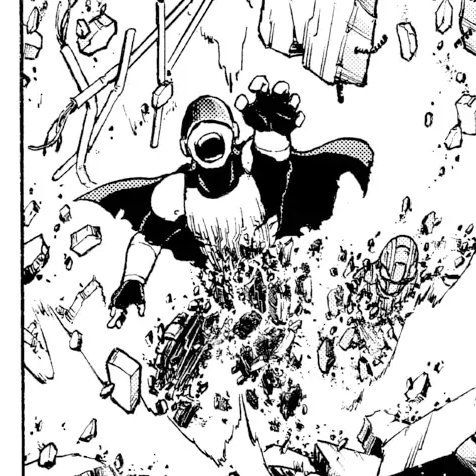
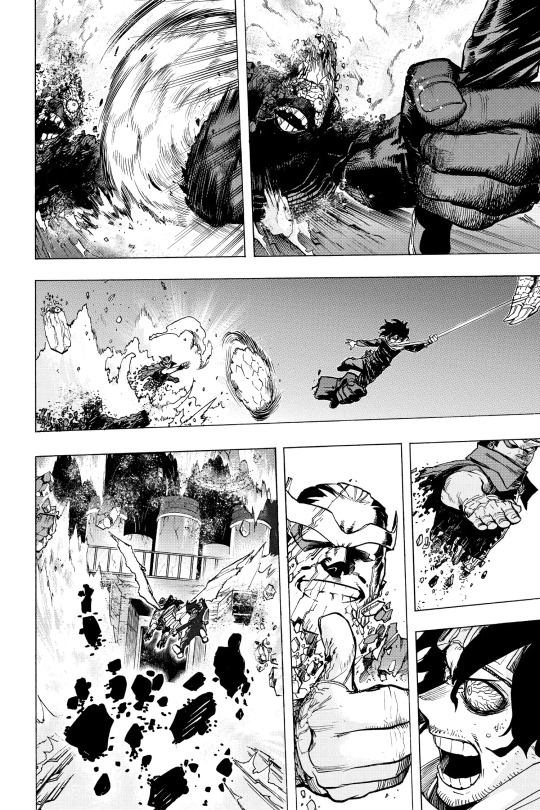

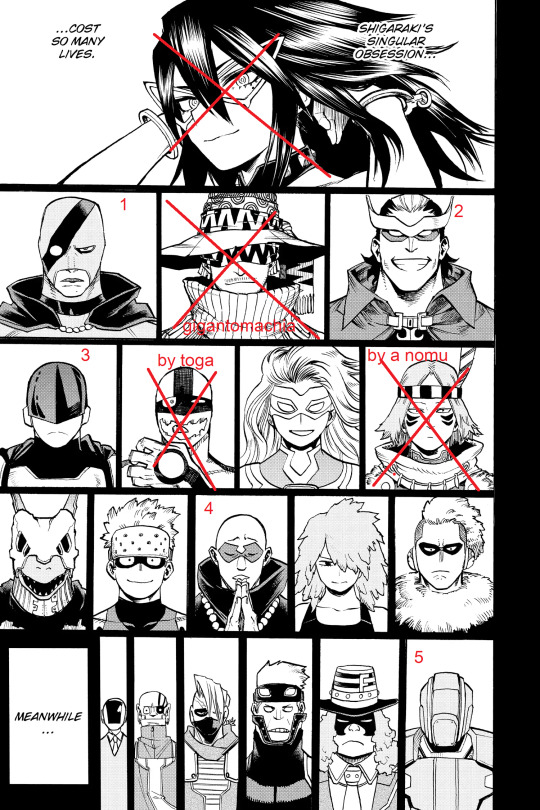
Since the city was evacuated, no one died besides a few heroes.
Tomura didn't kill anyone else during his fight against Endeavor and Izuku, so now we move on, with a kill count of around 61 visible kills and hmm.. 8,000 off screen?
I won't count any kill during the Tartarus scape since these where clearly by All for One
So we move to Stars and Stripes! Since here Tomura and AFO's personality where already half way, i'll count thise ones too. So more 2 kills here


Then the final arc begins, but despite the absolute mess the fight against Tomura in the UA cage was- it had no deaths besides Bakugou.
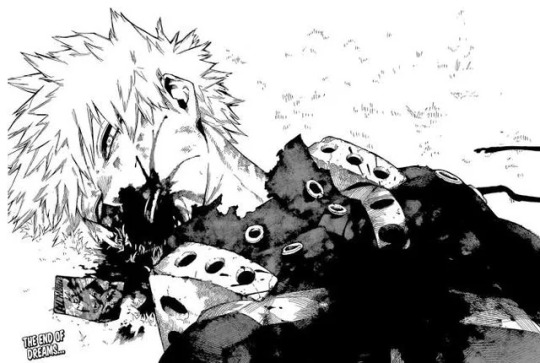
FINAL COUNT:
On screen kills by Tomura: 61 kills
Kills counting ShigAFO: around 64
Kills counting off-screen deaths: around 1,000 to 9,000
Bonus: Nine lol
Ngl, owned too

Now you're probably thinking: uhh- that's still a lot of people.
But the thing is, he killed much less than it looks like, literally all kills where out of self defense or necessity, very few in the list where innocent people, the vast majority are villains, and he never killed for pleasure or in a act of sadism.
Actually, he had very good reasons to kill each one of them.
Yes yes, he did attempt to kill much more, but he didn't.. Even if he did kill "millions" because of Deika- he's still not the monster he is portrayed by some.
Like come on, if you had an entire city trying to kill you, you wouldn't try to defend your self in your way to rescue a friend? If someone threatened you and had brutally killed your friend and taken another's arm, you wouldn't feel joy in vengeance?
Anyways, Tomura is innocent
"The reason why he killed them or how he felt doesn't change the fact he killed them!"
If so same for Gran Torino's "killing is a form of saving" ass!
Like come on, look at him!
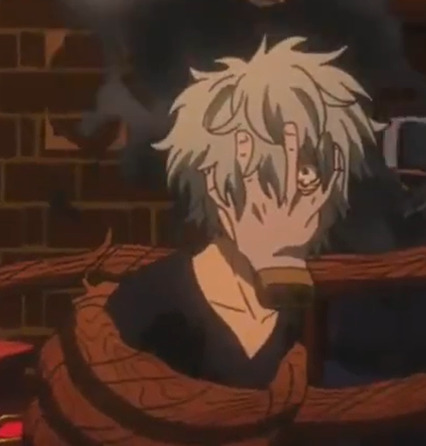
Anyways, my job here is done 😌
#shigaraki tomura#tomura shigaraki#shigaraki#bnha#mha#boku no hero academia#my hero academia#tomura#mha thoughts#mha analysis#bnha analysis#mha shigaraki
200 notes
·
View notes
Note
Talking about the ua bots, wasn't it mentioned somewhere that there was an atempted robot uprising?
Horikoshi allegedly stated this in an interview but I don't speak Japanese so my source is second or third hand.
Additionally, in one of the Vigilantes bonus chapters, All Might fights a Zero Pointer.
17 notes
·
View notes
Text
Having now read the official release of MHA 407, I don’t (yet) see the argument that AFO was a traumatized baby who was just looking for someone to respond to his cries and take care of him the way that Tenko was wandering the streets. While it’s revealed that AFO doesn’t want to be alone, AFO’s backstory and Tenko’s backstory reveal two very different men with different motivations.
The narrative in 407 says young AFO distrusts anyone who won’t turn and look at him when he cries because those people don’t offer anything of value to him. He can’t manipulate them into doing what he wants, and therefore they are useless and he can kill them if he wants. This has long been AFO’s thought pattern, and it’s what he taught young Tenko — YOU are more important than anything, and YOU should always act how you desire. Nothing in the world matters except what YOU want to do.

Contrast that with young Tenko’s initial reactions when realizing he killed his family, and with Tomura’s later hesitation to kill (or even attack) Katsuki after Katsuki refuses to join the LOV. Tenko/Tomura cares about other people, even after they refuse him, in a way that AFO does not.

Moreover, look at young AFO’s faces. He isn’t shown smiling or crying or having any emotion at all until page 11, when he reveals he killed the glowing child and stole their quirk. He then grins widely as he talks about his dream of a world that exists only for him. AFO didn’t smile when killing the anti-meta group OR when reading with Yoichi. He has no happy, smiling memories prior to this moment (even with Yoichi), unlike Tenko who had fond memories of his mom, sister, friends, and dog.
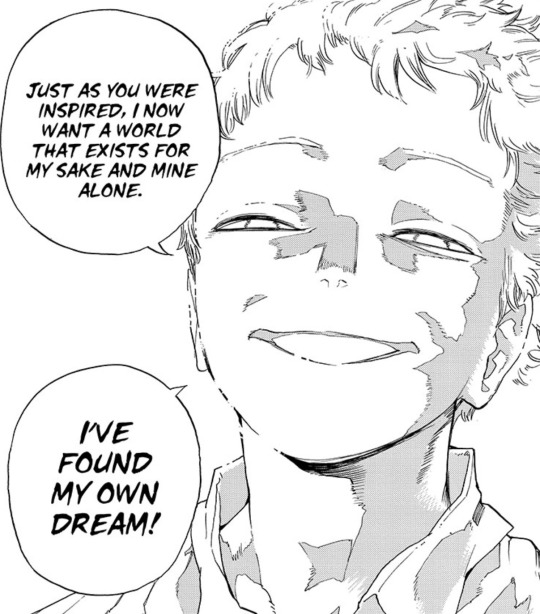
As another point of contrast, look at why AFO wants to be the villain: He wants to be surrounded by people who pay tribute to him. He does not want to “battle on in solitude.” (Another reason why AFO hated All Might for smashing his face in — it required a lengthy recovery hidden away from followers.)

To AFO, people are a one-way relationship. He doesn’t want to be alone, so he wants to possess a brother who directly opposes everything AFO stands for; a brother who is family and who wishes for the best but will never be a supporter, follower, ally, or friend. AFO gives Yoichi a quirk thinking that will change Yoichi’s mind, or keep him somehow bound to AFO.
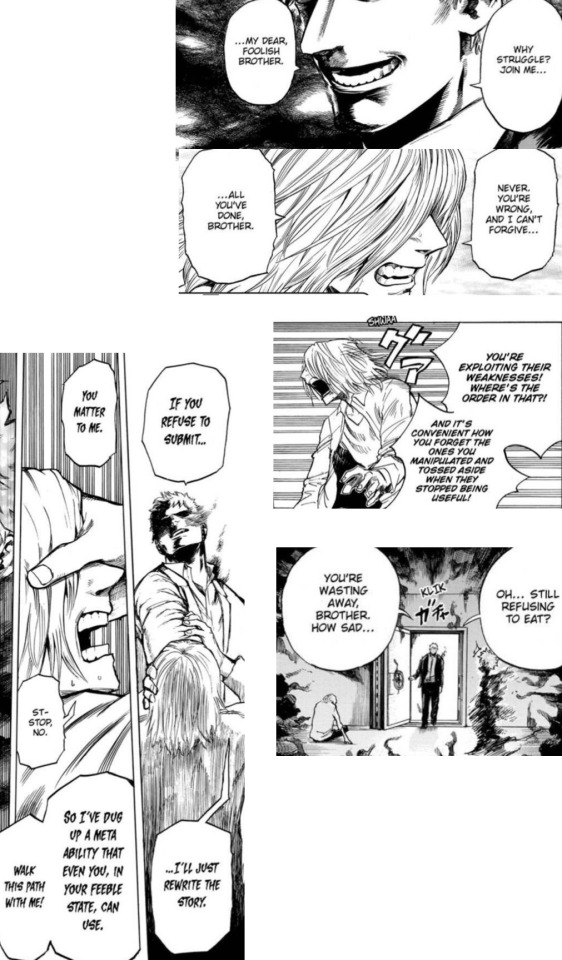

Tomura, however, wants allies, and in return he wants to give back to them. He got downright DEFENSIVE when Mirio said he didn’t have any friends. Tomura understands the give-and-take involved in working with people. He doesn’t just want followers that do his bidding.
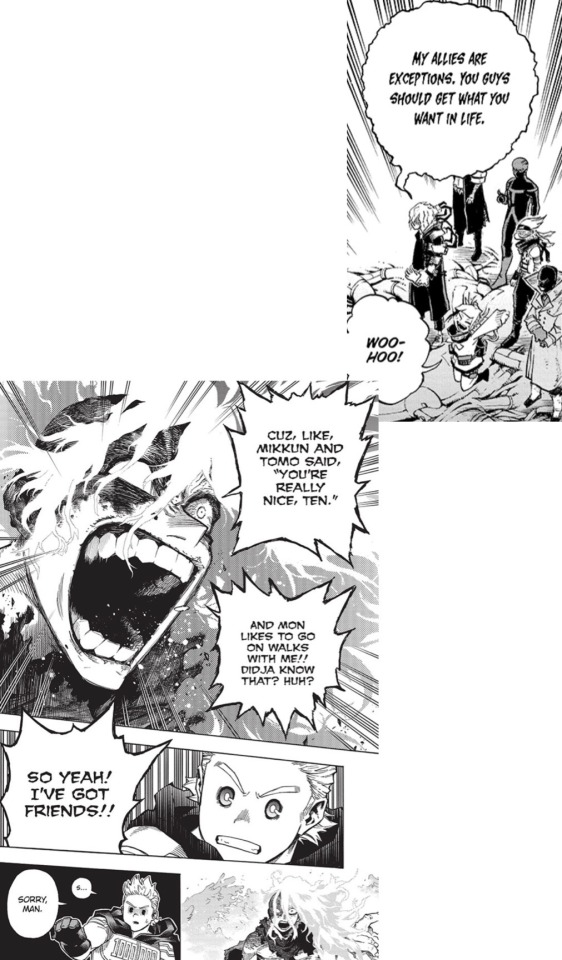
In the end, AFO’s unrelenting selfishness will leave him alone — at some point he will run out of “followers” and paths to victory. Meanwhile, Yoichi and Kudou built a network that ensured they would not be alone in their battle. They found true allies in the other OFA holders, and in turn Izuku found allies among pro heroes and at UA, just as Tomura did in the LOV. They are not alone.

#bnha 407#mha 407#bnha spoilers#mha spoilers#AFO#all for one#yoichi#mha yoichi#Kudou#mha kudou#2nd ofa user#second ofa user#tomura shigaraki#Tenko shimura#mha meta#bnha meta
328 notes
·
View notes
Text
I feel it's maybe relevant to point out that Shigaraki's Decay quirk is 『崩壊』 [houkai] in the original Japanese:


Which translates to "collapse" or "break down":

Containing within it the kanji that Shigaraki likes to use: to break or destroy - 壊す
"Decay" is an accurate translation, and imo is snazzier and better sounding for a superpower name in English, but does bring with it the connotation of something that decomposes or declines, and gradually;
whereas houkai/'collapse' is usually used to talk about things like the downfalls of regimes and government, buildings and structures giving way and coming down, or families and relationships going to ruin - destruction.
This is in the grand scheme of things in the story an extremely minor translation detail here, but I bring it up because I think no matter how Shigaraki ends up receiving the 'Decay' quirk - whether it's his innate own or it was given to him by AFO - it's undeniable that Shigaraki had embraced this power as his own. His goal is to destroy the current status quo/Hero Society as exists now. Even if it was an idea taught to him at first, it has become something he - and the League - genuinely wanted, for themselves, for each other.
With or without using his quirk; and whether it's making cracks in UA's reputation, causing All Might's retirement, contributing to the fall of the Shie Hassaikai or the Meta Liberation Army, or being responsible for the current semi-failed-state situation of HeroAca Japan, Shigaraki's been enthusiastically embodying "the collapse of things" for a long while now.
104 notes
·
View notes
Link
In BNHA there is a school that teaches teenagers how to become heroes! But do readers think it's a good school with good teachers?
#Hopefully people aren't sick of these#I figured these were a way to get a pulse on people's thoughts#without making them uncomfortable#BNHA#MHA#bnha meta#bnha survey#Is UA a good school?#UA#ultra academy#mha meta
5 notes
·
View notes
Text
Let's talk about the insane idea promoted by the hero society that self-sacrificing and sadness is better than hurting others and feeling rage. Or in other words, how dying for other and repressing your feelings even if they destroy you is better than becoming violent and letting your rage affect the course of the daily basis.
For the hero society, submissive individuals were better. Depressed as in being unable to act was better. Passive behavior was better. It's easier to feel pity and hold some mourning for the victims before moving on as if nothing happened.
Take Deku. If he had died by suicide only a few would care. He was an unimportant quirkless kid with no real potential to be a hero. Or if he had died saving Bakugo he would have become a martyr, a quirkless kid who got to be a hero for a day before tragically dying. The end.
That is why Aizawa is mad with All Might when he sees Deku. He could have died in the UA entrance test, it was impressive but what about Deku's life. That's also what Recovery Girl told All Might in the UA Sport Festival. That's what Deku needed to learn when he started using kicks instead of punches. Self-sacrificing shouldn't be idolized by the hero society. Ultimately, it is murder in the hands of the authorities who enforce such idea.
Take the League of Villains.
Ugly victims don't get help.
⠀
Ask Tenko. Walking alone on a busy street, with blood on his hands and eyes totally lost. No one helped him. He was not a cute kid crying like Eri, he was monstrous like. His accident was not one caused by a victim. It was the abuse of his father and tje unfortunate awakening of his quirk that ended with him murdering his entire family.
If he had stayed sitting silently, unable to weep or talk or cry, he would have died and no one would have known. Society would be happy because there's no Shigaraki Tomura, right?
Touya died on a forest fire and life moved on. His dad became even more abusive and reached the number one spot on the hero charts. Like the past never happened.
Toga's neglected childhood pushed her to the point she exploded and drank the blood of someone, but because she was already a monster like looking child, she wad regarded as a danger and his parents erased her presence from their house. If she had died on the streets or gotten captured, people would just think "good, one less psycho, we can keep going with our days".
Visually, it's easier to sympathize with a crying victim full of sadness and wounds. Some animal instinct of who knows. I don't. BUT it's way harder to sympathize with someone who shows their hurt by being very disruptive, loud, angry, violent. Especially if they can't cry, singe people equals crying to regret or pain. If someone is unable to cry, there must be something wrong with them.
⠀
The League of Villains goal in the narrative at the beginning of bnha is less Stain-like (there are a few bad apples in the basket we need to purge and everything will be good again) and more of Shigaraki's own ideology: society is rotten to the bone, even the greatest of heroes is corrupted and the cycle of violence is being used by the hero society as an excuse to control the public.
Funny. It was not a lie. With Lady Nagant's story and even with Hawk's we were witnesses of how the hero society was indeed rotten. And we saw a few paragraphs above why All Might was part of the corruption, if with good intentions, but still an important part of it.
There are two main responses to trauma in bnha. The hero society prefers the one that doesn't make them look bad.
⠀
So, what's the kick?
What happened with the League of Villains would have happened eventually with any other group of individuals. It was a natural reaction to a failed system, one AFO took advantage of in order to further his plans.
There was the Meta Liberation Army, where many or his members were pro-heroes btw. There was the situation with Overhaul and the whole issue with the quirk repressing drug. You had Aoyama, the hospital full of kids Touya woke up to, etc.
In order for a change to happen, a reactive factor was needed. Individuals who were not afraid to threat the commodities of the population, their peace of mind, people willing to ne disturbing and people able to shake the hero society foundations. It's not coincidence that those individuals were the same victims who, after being passive for so long, decided peace was not an option.
Am I justifying the actions of the League and blaming everything on the heroes ? No, I'm not.
Killing is killing. Murder is murder. We're not going machiavelli on here and saying they had no other choice (both heroes and villains).
What I'm saying is that both sides were equally right and wrong. Many heroes and villains got used by bigger players in the game. Ultimately the fight started being between the institutions of power around the world and AFO. In Japan, it was the Hero Commission.
Like in any other war, many heroes and villains killed each other thinking it was the right thing to do in order to help society reach higher ground, get better, heal, be safe, whatever. Brainwashed for sure, loyal to a cause that's not loyal to them.
⠀
The kick is in balance.
You can't take the blame of other actions and punish yourself for it. You can't make others responsible of your own actions either. You shouldn't be putting your life above others and you shouldn't be putting their lives below you.
Learning to separate the responsibilities, to notice the shades in which anger and sadness mix, to be able to say "we all matter equally" and know it means a victim can be an abuser too and deserves help as much as they should be hold accountable for. These are the struggles of bnha.
Good communication to avoid mindless violence.
There's where Deku and Tomura meet, in the middle of those lines. There's where Shoto and Dabi meet, where Toga and Ochako meet.
The Messiahs vs The Judas, assigned a role to play by society, either die or be killed tragically. The moment they can shed of those roles and see each other as human beings, that's the moment things will start changing for good.
#bnha#mha#boku no hero academia#my hero academia#Bnha meta#Mha meta#Shan's bnha meta#Shan's mha meta#mha spoilers#bnha spoilers#lov#league of villains#Midoriya Izuku#Deku#shigaraki tomura#Tenko Shimura#Toga himiko#Dabi#Touya Todoroki#Toya todoroki#Afo#All for one#Horikoshi#uraraka ochako#shoto todoroki#todoroki shouto
567 notes
·
View notes